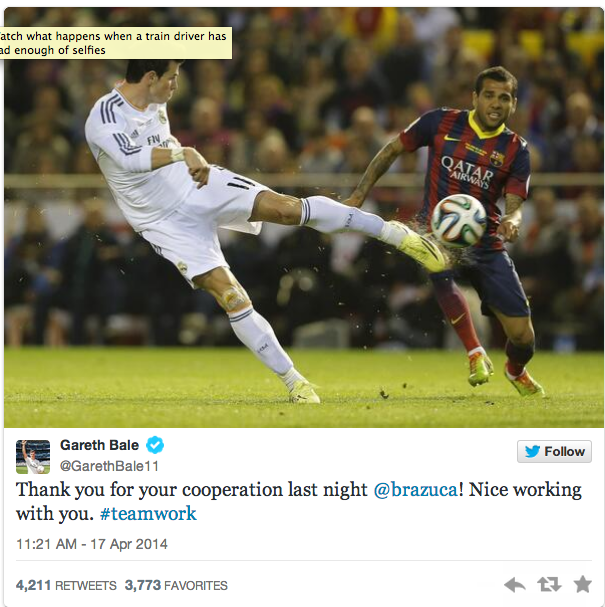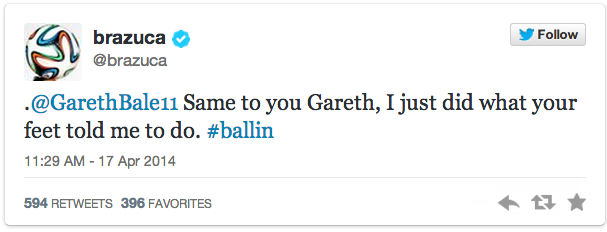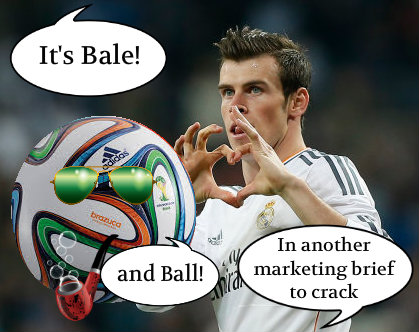Bale & Ball: Real Madrid Star And Adidas Brazuca Crack Another Case Of Desperate Marketing
GARETH Bale scored a terrific goal last night to win the Copa Del Rey for Real Madrid. But he never thanked God, as many players do. Bale thanked the ball. He thanked the Adidas Brazuca for obeying his foot and not behaving like a beach ball on a windy day on a Bridlington beach.
The former Spurs and Southampton man tweeted:
“Luv u babe lol xx”

And then the ball tweeted Bale back:

Chris at Pies calls it “a brand spanking new low in the commercialisation of football”.
But is it. Football’s have gone out of fashion as objects of desire. Back in the days of pre-Premier League England, kids would gather round the Christmas tree as wonder what was inside that round parcel that wouldn’t sit still. Was it a big black bomb from a comic? A giant fat-ball to hang above the bird bath? A soap-on-a-rope for Giant Haystacks?
No, it was a proper leather football.
Once upon a time a ball, like a dog, a football was a treat, an object of wonder what you nurtured for years. They cost an arm and a leg, and that wasn’t the half of it: when it rained they were heavy and hard enough to break the other arm and leg.
The Encyclopaedia of British Football summed up the impact of a regulation Size 5:
“On wet days the ball grew increasingly heavy as the leather soaked up large amounts of liquid. This, together with the lacing that protected the valve of the bladder, made heading the ball not only unpleasant but also painful and dangerous.”
Stan Cullis of Wolves and England was knocked out and seriously injured twice during matches as a result of heading the ball and having it fired into his face, and retired on the advice of doctors. Like many players of his era, he suffered dementia, often attributed to heading the old-style balls.
If there was no proper ball, children in the Sixties and Seventies made do with a plastic substitute. A youngster would have trouble getting a corner into the box using the leather ball, but these black-and-white plastic baubles would fly into the air at the slightest touch, making it impossible to score from any range further than three yards.
Better by far was the Wembley Trophy – a heavy orange ball with fake panels embossed upon it. It came in a special presentation box, and could do almost as much damage as a leather ball, especially on cold days, when it would sting the thighs, smash the testicles and bring tears to the eyes of any boys foolish enough to block its path.
Help was on its way. In the 1970s balls were coated with polyurethane to stop water retention. Today’s versions have a latex bladder and a synthetic leather casing, while Adidas World Cup balls are thermally bonded and machine-pressed.
They are soulless. But thanks to Bale, the football could once more be sold as part of the player. We’d investigate the ideal of Bale and the ball further, possibly though the Saturday morning comic strip Bale & Ball, available in all newspapers.
What’s that you say. No-one buys newspapers anymore?
Sounds like a job for Bale & Ball… Gareth! Crank up the maketingometer, it’s gonna be a long day!
Posted: 17th, April 2014 | In: Sports Comment | TrackBack | Permalink



